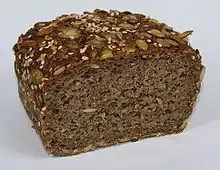Multigrain bread
Multigrain bread is a type of bread prepared with two or more types of grain.[1] Grains used include barley, flax, millet, oats, wheat, and whole-wheat flour,[2][3] among others. Some varieties include edible seeds in their preparation,[4] such as flaxseed, quinoa, pumpkin seeds, and sunflower seeds.[3][5] Rye and sourdough multigrain breads are additional varieties.[4][6][7] Preparations include 7-grain and 9-grain bread,[8] among others.

Multigrain bread may be prepared using whole, unprocessed grains,[9] although commercial varieties do not necessarily always contain whole grains.[1]
Nutritional content
Whole grain multigrain breads contain a dietary fibre content of up to four times greater than white breads[4][10] and may also contain more vitamins and protein compared to white bread.[11] Multigrain breads also provide complex carbohydrates.[12]
Commercial varieties
Multigrain bread is commercially mass-produced and marketed to consumers.[13] Some commercial varieties are prepared using 100% whole grain flour.[13] Between 1989 and 1994 in the United States, multigrain bread was "one of the fastest growing markets within the bakery sector".[14]
Use in brewing
A 4,000-year-old Mesopotamian recipe for brewing beer from multigrain loaves of bread mixed with honey is the oldest surviving beer recipe in the world.[15] The Brussels Beer Project microbrewery in Belgium has developed an amber beer with a 7% alcohol by volume named Babylone that incorporates this recipe using leftover, unsold fresh bread donated by supermarkets.[15][16][17]
See also
References
- Kirkpatrick, Kristin (February 20, 2014). "6 Ways the Food Industry Is Tricking You". U.S. News & World Report. Retrieved May 1, 2015.
- Media, Demand (April 29, 2015). "Rye Bread Vs. Multigrain Bread". SFGate.com. Retrieved May 1, 2015.
- Katzin, C.F. (2010). The Everything Cancer-Fighting Cookbook. Everything®. F+W Media. p. 246. ISBN 978-1-4405-0747-2.
- NewsLifeMedia (April 30, 2015). "News". Taste.com.au. Retrieved May 1, 2015.
- "What's the best bread for your family?". News.com.au. May 1, 2015. Retrieved May 1, 2015.
- Reinhart, P. (2011). Crust and Crumb: Master Formulas for Serious Bread Bakers. Potter/TenSpeed/Harmony. p. 278. ISBN 978-1-60774-132-9.
- Suas, M. (2008). Advanced Bread and Pastry. Cengage Learning. p. 227. ISBN 978-1-4180-1169-7.
- Decker, J.; Neuhaus, E. (2005). The World's Fittest You. Penguin Group US. ISBN 978-1-101-21999-7.
- Harrington, Theresa (November 30, 2012). "Mt. Diablo school district cooks up a tasty multigrain bread". San Jose Mercury News. Retrieved May 1, 2015.
- Wilkins, L.W. (2007). Nutrition Made Incredibly Easy. Incredibly easy. Lippincott Williams & Wilkins. p. 256. ISBN 978-1-58255-521-8.
- Gupta, P.; Gupta, D. (2013). Losing It! Making Weight Loss Simple. Pan Macmillan. ISBN 978-1-4472-4244-4.
- Evans, J.; Aronson, R. (2005). The Whole Pregnancy Handbook: An Obstetrician's Guide to Integrating Conventional and Alternative Medicine Bef ore, During, and After Pregnancy. Penguin Publishing Group. p. 224. ISBN 978-1-4406-2342-4.
- "Bimbo To Buy Canada Bread From Maple Leaf For $1.66 Billion". Getty Images. February 12, 2014. Retrieved May 1, 2015.
- "Food Processing". Volume 63. Techpress (FPI) Limited. 1994. p. 36. Retrieved 30 April 2015.
- Bartunek, Robert-Jan (April 17, 2015). "Brussels brewer uses leftover bread to make beer". Reuters. Retrieved May 1, 2015.
- Szal, Andy (April 23, 2015). "Belgian Brewery Turns Food Waste Into Beer". Manufacturing.net. Retrieved May 1, 2015.
- "Babylone - from bread to beer". Beer Project Brussels. April 20, 2015. Retrieved May 1, 2015.
Further reading
- Indrani, D.; et al. (June 2010). "Multigrain bread–its dough rheology, microstructure, quality and nutritional characteristics". Journal of Texture Studies. 41 (3): 302–319. doi:10.1111/j.1745-4603.2010.00230.x. (subscription required)
- Henriques, A.S. (2000). The Effects of Gum Incorporation on the Staling Properties of Multigrain Bread. University of Georgia. 316 pages.
External links
 Media related to Multigrain breads at Wikimedia Commons
Media related to Multigrain breads at Wikimedia Commons

